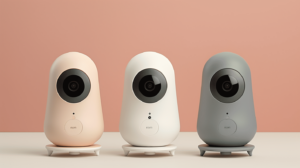
Toddler and Sibling Activities for Cultural Awareness
Discover engaging toddler and sibling activities that promote cultural awareness and embrace diversity. Cultivate a sense of inclusion and understanding.
Welcome to the ultimate guide to baby monitors! If you’re a new parent or expecting a little one soon, then you’ve come to the right place. In this comprehensive guide, we’ll dive deep into the world of baby monitors and how they can elevate your parenting game.
As a parent, one of your top priorities is the safety and well-being of your baby. Baby monitors play a crucial role in helping you keep a watchful eye and ear on your little one, even when you’re not in the same room. Whether you’re in the next room, downstairs, or even outside, a baby monitor provides you with peace of mind knowing that you can always keep an eye on your baby.
In this guide, we’ll cover everything you need to know about baby monitors – from understanding what they are and the different types available, to choosing the right one for your needs and maximizing its use. We’ll also provide valuable tips for troubleshooting and maintenance, ensuring the safety of your baby monitor, and even explore alternative uses for these devices.
So grab a cup of coffee or tea, and let’s dive in! By the end of this guide, you’ll be well-equipped with the knowledge and confidence to choose the perfect baby monitor for your family. So let’s get started and make parenting a whole lot easier!

Let’s dive into the world of baby monitors and understand what they are all about. Whether you’re a new parent or already have kids, a baby monitor can be a valuable tool to help you keep an eye and ear on your little one, providing peace of mind and enhancing your parenting experience.
A baby monitor is a device that allows you to remotely monitor your baby while they sleep or play in another room. It typically consists of two main parts: a baby unit and a parent unit. The baby unit is placed near the baby, often in their nursery, while the parent unit is carried around by the caregiver.
The baby unit is equipped with a microphone to pick up sounds, such as crying or babbling, and sometimes a camera to provide visual monitoring. The parent unit receives the audio and/or video feed from the baby unit, allowing parents to hear and see what is happening in real-time.
There are several types of baby monitors available on the market. Each type has its own features and benefits, so it’s important to consider your needs and preferences when choosing the right one for your family. Here are the most common types of baby monitors:
When choosing a baby monitor, there are some key features to consider that can enhance your monitoring experience and ensure the safety and comfort of your baby. Here are a few features to look out for:
Remember, every family has different needs and preferences. Consider what features are most important to you and your family when selecting a baby monitor.
When it comes to choosing the right baby monitor, there are several factors to consider to ensure that you make the best decision for you and your little one. From assessing your needs to understanding the different types of monitors available, here’s what you need to know:
Before making a purchase, it’s important to assess your specific needs and requirements. Take a moment to consider the following:
Understanding your needs will help you narrow down your options and find a baby monitor that suits your lifestyle and preferences.
One crucial aspect to consider when choosing a baby monitor is its range and connectivity. The range refers to the distance at which the monitor can transmit audio or video signals between the baby unit and the parent unit. If you have a large home or plan on using the monitor in multiple rooms, it’s essential to choose one with a long enough range to maintain a strong connection.
Additionally, consider the connectivity options available. Some monitors use Wi-Fi or Bluetooth technology to connect, while others rely on radio frequencies. Make sure the monitor you choose has a reliable and secure connection that fits your needs.
One of the primary decisions you’ll need to make when selecting a baby monitor is whether you prefer a video monitor or an audio-only monitor. Here’s a breakdown of the pros and cons of each:
Ultimately, the decision between video and audio monitors will depend on your personal preferences and requirements.
When choosing a baby monitor, keep an eye out for these additional features that can enhance your monitoring experience:
Consider which of these features are important to you and prioritize them when looking for a baby monitor.
Remember that every family’s needs and preferences are unique, so take the time to research and compare different models before making your final decision. By choosing the right baby monitor, you can enjoy peace of mind knowing that you can keep a close eye (or ear) on your little one, even from a distance.
Setting up a baby monitor is an important step in ensuring your little one’s safety and your peace of mind. Here are some tips to help you set up your baby monitor correctly:
When it comes to placing your baby monitor, consider these factors:
Maintaining the security of your baby monitor is crucial for protecting your family’s privacy. Here’s what you can do:
Connecting and syncing your baby monitor devices can sometimes be a bit tricky. Here are steps to help you get it right:
By following these tips, you can set up your baby monitor correctly and enjoy a reliable and secure monitoring system for your little one. Remember to regularly check the monitor’s functionality and adjust the settings as needed to provide the best monitoring experience.
Pro Tip: Consider using a baby monitor with a portable receiver so that you can carry it with you around the house. This allows you to stay connected with your baby even when you’re not in the same room.
Once you’ve chosen the perfect baby monitor for your little one, it’s time to explore all the features and functionalities it offers to maximize its use. Here are some tips on how to get the most out of your baby monitor:
Remember, every baby is different, so it’s important to experiment with the different features and settings to find what works best for you and your little one. Keep in mind that not all baby monitors will have all these features, so make sure to choose a monitor that aligns with your specific needs and preferences.
Utilize the various features of your baby monitor to create a safe and comfortable environment for your little one while also providing you with peace of mind.
When it comes to baby monitors, it’s important to ensure they are working properly to keep an eye on your little one. Here are some tips for troubleshooting common issues and maintaining your baby monitor:
Signal interference can disrupt the connection between your baby monitor and the receiver, leading to poor audio or video quality. Here’s what you can do to minimize signal interference:
Even with the best baby monitor, you may encounter some common issues. Here are a few troubleshooting tips to help you resolve these problems:
Regular cleaning and maintenance can help prolong the life of your baby monitor and ensure it functions smoothly. Here are some tips:
By following these tips for troubleshooting and maintenance, you can ensure that your baby monitor is always in good working condition, providing you with peace of mind as you keep an eye on your little one. Remember, if you’re still experiencing issues with your baby monitor, consult the manufacturer’s manual or reach out to their customer support for further assistance.
“Troubleshooting and maintaining your baby monitor is crucial to ensure it functions properly. By following these tips, you can troubleshoot common issues and keep your monitor in optimal condition, providing you with peace of mind.”
When it comes to using baby monitors, safety should always be a top priority. After all, you want to be able to keep a close eye on your little one without any worries. Here are some essential tips to ensure the safety of your baby monitor:
It’s important to remember that while baby monitors can greatly assist in monitoring your child’s safety, they are not a substitute for parental supervision. Always prioritize your own presence and vigilance when it comes to your baby’s well-being. Taking the necessary safety precautions will provide peace of mind and ensure a secure environment for your little one.
“Safety is paramount when it comes to using baby monitors. By following these guidelines, you can rest assured that your little one is being monitored in a secure and safe manner.”
When it comes to baby monitors, choosing the right accessories can enhance your monitoring experience and provide added convenience. Here are some essential accessories to consider:
Remember, it’s important to choose accessories that are compatible with your specific baby monitor model. Be sure to check the manufacturer’s recommendations and compatibility before making a purchase.
Adding accessories to your baby monitor setup can provide added convenience and flexibility in monitoring your little one. With the right mounts, additional cameras, or portable receivers, you can customize your monitoring experience to suit your needs. So, go ahead and elevate your parenting game with these must-have accessories for your baby monitor!
Go back to the Article Outline
While baby monitors are primarily designed to monitor your little one’s safety and well-being, they can also have some alternative uses that you may not have considered. Here are a couple of unexpected ways you can repurpose your baby monitor:
If you have pets at home, you can use your baby monitor to keep an eye on them when you’re not around. This can be especially useful if your pet has separation anxiety or if they tend to get into mischief when left alone. By placing the monitor in the room where your pet spends most of their time, you can check in on them and ensure they’re not getting into any trouble.
Benefits of using a baby monitor for pet monitoring:
Another alternative use for baby monitors is as a basic home security system. By strategically placing the monitor in different areas of your home, you can monitor and keep tabs on what’s happening when you’re not there. This can be particularly helpful if you travel frequently or if you live in a neighborhood with high crime rates.
Advantages of using a baby monitor for home security:
Remember that while baby monitors can be used for these alternative purposes, they are not specifically designed to replace dedicated pet monitors or robust home security systems. However, they can offer some additional peace of mind and convenience in certain situations.
Before repurposing your baby monitor for these alternative uses, make sure to consider a few important factors:
While these alternative uses may not have been the primary reason you purchased a baby monitor, they demonstrate the versatility and multi-functionality of these devices. So go ahead and repurpose that baby monitor to keep an eye on other important aspects of your life!
Congratulations! You’ve now reached the end of the ultimate guide to baby monitors. We hope that this comprehensive article has provided you with valuable insights and information to help you choose and make the most of your baby monitor.
Throughout this guide, we’ve discussed the different types of baby monitors available, the key features to consider, and how to choose the right one for your specific needs. We’ve also covered important topics such as setting up the monitor, maximizing its use, troubleshooting and maintenance tips, and ensuring baby monitor safety.
Remember, when choosing a baby monitor, it’s crucial to assess your needs and consider factors like range and connectivity, video vs. audio monitors, and any additional features you may find useful. Setting up the monitor correctly and finding the ideal placement will enhance its effectiveness in monitoring your baby’s sleep and safety.
Make sure to familiarize yourself with the various features your baby monitor offers, such as sound and motion detection, temperature and humidity monitoring, two-way communication, night vision, and lullabies. These features will not only provide you with peace of mind but also help you better care for your little one.
In addition to using your baby monitor for its primary purpose, you can also explore alternative uses like pet monitoring and home security. By utilizing the right accessories such as mounts and stands, additional cameras, and portable receivers or apps, you can enhance the functionality and convenience of your monitor.
Lastly, always prioritize the safety and privacy of your baby and your family. Take steps to prevent hacking and ensure that you follow baby monitor safety guidelines. Regularly clean and maintain your monitor to ensure optimal performance and longevity.
We hope this guide has empowered you with the knowledge to elevate your parenting game with the help of a baby monitor. As technology continues to advance, baby monitors are becoming more sophisticated and user-friendly, making it easier than ever to keep a close eye on your little one.
Remember, a baby monitor is more than just a gadget – it’s a tool that provides you with peace of mind and allows you to be there for your baby, even when you’re not in the same room. So go ahead and invest in a reliable and feature-rich baby monitor – you and your baby deserve it!
Be the first to See our Posts and latest Guides, and Special Offers like Lovelycheeks on Facebook or follow us on Pinterest!

Discover engaging toddler and sibling activities that promote cultural awareness and embrace diversity. Cultivate a sense of inclusion and understanding.

Discover educational and nurturing gardening activities for toddlers. Enhance their learning and development through hands-on experiences with nature.

Discover effective tips for nurturing sibling relationships and fostering a strong bond between siblings. Create lasting connections and promote harmony.

Discover the impressive features of the Nanit Baby Monitor and get valuable recommendations on choosing the perfect one for your baby’s safety and comfort.